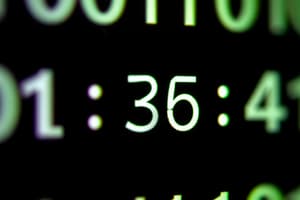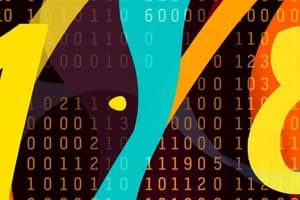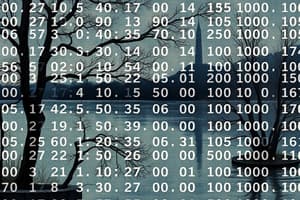Podcast
Questions and Answers
What is the correct binary representation of the decimal number 13?
What is the correct binary representation of the decimal number 13?
- 1001
- 1010
- 1110
- 1101 (correct)
Which number system uses base 16?
Which number system uses base 16?
- Octal
- Hexadecimal (correct)
- Binary
- Decimal
What is the primary difference between signed and unsigned binary numbers?
What is the primary difference between signed and unsigned binary numbers?
- Signed numbers require more bits than unsigned numbers for the same value.
- Unsigned numbers are limited to one byte; signed are limited to two bytes.
- Signed numbers can represent both positive and negative values; unsigned cannot. (correct)
- Unsigned numbers can only represent even values; signed can represent odd.
Which statement about compilers and interpreters is true?
Which statement about compilers and interpreters is true?
Which of the following correctly describes ASCII?
Which of the following correctly describes ASCII?
Flashcards
Binary Number System
Binary Number System
Uses only two digits (0 and 1) to represent numbers.
Decimal Number System
Decimal Number System
Uses ten digits (0-9) to represent numbers.
Hexadecimal Number System
Hexadecimal Number System
Uses sixteen digits (0-9 and A-F) to represent numbers.
Octal Number System
Octal Number System
Signup and view all the flashcards
Binary to Decimal Conversion
Binary to Decimal Conversion
Signup and view all the flashcards
Decimal to Binary Conversion
Decimal to Binary Conversion
Signup and view all the flashcards
Binary to Hexadecimal Conversion
Binary to Hexadecimal Conversion
Signup and view all the flashcards
Hexadecimal to Binary Conversion
Hexadecimal to Binary Conversion
Signup and view all the flashcards
Unsigned Binary Numbers
Unsigned Binary Numbers
Signup and view all the flashcards
Signed Binary Numbers
Signed Binary Numbers
Signup and view all the flashcards
ASCII
ASCII
Signup and view all the flashcards
UTF
UTF
Signup and view all the flashcards
Computer
Computer
Signup and view all the flashcards
Computer Architecture
Computer Architecture
Signup and view all the flashcards
Hardware
Hardware
Signup and view all the flashcards
Software
Software
Signup and view all the flashcards
Programming Languages
Programming Languages
Signup and view all the flashcards
Compiler
Compiler
Signup and view all the flashcards
Interpreter
Interpreter
Signup and view all the flashcards
Study Notes
Number Systems
- Binary uses 0 and 1.
- Octal uses 0-7.
- Decimal uses 0-9.
- Hexadecimal uses 0-9 and A-F.
- Conversions exist between binary, decimal, octal, and hexadecimal.
Binary Conversion
- Binary to decimal: Calculate the sum of powers of 2 based on the positions of 1s.
- Decimal to binary: Repeatedly divide by 2, recording remainders.
- Binary to hexadecimal: Group binary digits into sets of 4, convert each set to its hexadecimal equivalent.
- Hexadecimal to binary: Convert each hexadecimal digit to its 4-bit binary equivalent.
Binary Representations
- Unsigned binary represents positive values.
- Signed binary uses different representations (e.g., two's complement) to indicate positive and negative numbers.
ASCII and UTF
- ASCII: A character encoding standard using 7 bits to represent characters.
- UTF (Unicode): A character encoding standard supporting a wider range of characters than ASCII (using more bits).
Computer Definition
- A computer is a programmable machine capable of storing, retrieving, and processing data.
Computer History
- Computer evolution is discussed, but specific details are omitted.
Key Computer Terms
- Terms related to computers but specifics are not detailed.
Computer Architecture
- Computer architecture details are lacking
Hardware and Software
- Hardware is the physical components of a computer.
- Software is the set of instructions that tells the computer what to do.
Programming Languages
- Programming languages are ways to give instructions to a computer.
Compilers and Interpreters
- Compilers translate code into machine language at once.
- Interpreters translate code line by line.
Studying That Suits You
Use AI to generate personalized quizzes and flashcards to suit your learning preferences.




